San Jose Sharks forward, defenseman Brent Burns is second in the league among all players (not just d-men) in shots on goal with an absurd 53 through 12 games. That is a per-game average of 4.41 shots, or in other words, a full season’s pace of 362. For comparison’s sake, Joe Pavelski and Logan Couture led the Sharks last year in shots on goal with 263 and 261. Forwards are supposed to shoot more than defensemen since they spend more time closer to the net but Burns is on a historic pace for a defenseman in terms of shots on goal. There is just one problem, though.
Those shots aren’t doing much for the Sharks on the scoreboard. It’s a much smaller sample size through 12 games, but Burns’ shooting percentage is nearly a full percent lower than last season when he averaged 2.9 shots per game. Even us Corsi lovers (shot differential) admit that there is a matter of shot selection and not all shots are created equal. Take in point, San Jose lost Tuesday night 5-2, despite out-shooting Columbus 33-11 over the final two periods. The game was tied going into the second period and the Sharks out-shot the Blue Jackets three-to-one but still lost. San Jose took a lot of point shots, particularly Burns (four shots on goal in the game), but the team had a hard time creating chances from closer range.
Sharks Miss Couture
Full admission, yours truly was wrong about how much the Sharks would miss Couture. Clearly I had too much faith in Tomas Hertl and Chris Tierney to step up and fill the void. The saying goes that you don’t know what you had until it’s gone, and that is the case for me with Couture as second-line center. No. 39 is an annual 30-goal scorer and two-way center who is an integral part of the Sharks’ special teams, including the top power-play unit that has looked lost without him. With Couture out, the Sharks have had a tough time getting goals from anyone not named Joe Pavelski or Joel Ward. In the nine games since Couture’s injury, the Sharks’ roster outside Pavelski and Ward has combined for just six goals. Pavelski and Ward meanwhile have combined for 14. That is simply too top heavy.
Fixing Sharks’ Scoring Problems
An obvious answer (obvious to many outside the organization anyway) to fix this scoring problem is to move Burns back to forward. The Sharks though, for whatever reason, are adamant about playing Burns as a defenseman. They are dead set on leaving him at defense despite his natural (was drafted as a forward) offensive tendencies that cause him to make bad turnovers and leave his defense partner out to dry on odd-man rushes against. The Sharks know exactly how dominant Burns can be as a forward and they would be wise to make it happen again. His natural position is where he belongs and in reality, he would not be leaving as big of a hole on the blue line as people seem to think.

A common misconception among hockey fans is looking at a defenseman’s ice time and forming an opinion that they are irreplaceable because they skate 25 minutes per night. The problem here is that when judging a defenseman’s true effectiveness, fans should be looking at goals-for percentage at even strength, Corsi and quality of competition rather than merely minutes played. Burns had a solid Corsi last season but his goals-for percentage was significantly below 50 percent at 47.1. What this means is the Sharks accounted for only 47 percent of the goals scored at five-on-five with Burns on the ice while their opponents accounted for 53 percent. Does that sound good enough for a nearly $6 million defenseman to you? It shouldn’t. If you are paying top dollar for a player, he should make your team at least equal to the average opponent at even strength, preferably better, and definitely not worse. For reference, the Sharks also scored 47 percent of the goals when the infamous enforcer John Scott was on the ice last season.
Defenseman Burns Not a Difference Maker at Evens
Thus far this season, Burns’ goals-for percentage through 12 games is worst of all Sharks blueliners that have played over 100 minutes at even strength. A small sample to be sure, but after adjusting back to the blue line last season, one would have hoped his defensive miscues would have improved. Thus far, that hasn’t been the case as the Sharks have allowed the opponents to score 60 percent of the goals at even strength with Burns on the ice this season. Burns’ crazy shot totals aren’t helping a whole lot when those shots aren’t creating goals on the offensive end and his turnovers and poor positional play have led to goals against.
The fact of the matter is moving Burns up to forward would be a huge boost to the offense and would hardly (if at all) hurt the team defense. While Burns has been skating big minutes against some tough players, the Sharks are equipped enough to handle his absence from the blue line. When Burns was a forward for the entirety of the 2013-14 season, the Sharks were an amazing team despite only having three defenseman that were impact players. Marc-Edouard Vlasic, Justin Braun and Jason Demers were terrific that year. The rest of the Sharks’ defense, however, (Matt Irwin, Brad Stuart, Dan Boyle and Scott Hannan) was simply not very good. San Jose flourished in spite of their thin defense because they were so incredibly deep at forward while Vlasic, Braun and Demers played lights out on the blue line. This season, the Sharks have a similar defense corps to 2013-14 when you take away Burns from the group. Vlasic, Braun and Paul Martin can be this season’s Vlasic, Braun and Demers. Plus Brenden Dillon, Matt Tennyson, Dylan Demelo and Mirco Mueller are comparable to the likes of Irwin, Stuart, Hannan and a horrid year out of Boyle in 2013-14.

Sharks Far More Potent With 88 at Forward
If San Jose were to make this switch again (they won’t but they should), Vlasic, Martin and Braun could easily absorb Burns’ minutes against top players, and the replacement defenseman (likely Demelo) is capable enough of playing 13-14 minutes per night without being a liability at even strength. Burns would continue to play the point on the power play, and primarily increasing Vlasic’s minutes at five-on-five to offset the move is a good thing. Vlasic is currently riding a terrific 60 percent goals-for percentage. Currently he sees less ice time five aside than Burns does and that is a big mistake. This Sharks team should be giving Vlasic top-10 even-strength minutes in the NHL; he is that good. Besides, if you put Couture and Burns in the below lineup as forwards, the Sharks should crush their competition even if the blue line were below average. If these were the forward lines at some point this season (not even including Melker Karlsson or Raffi Torres), the blueliners wouldn’t have to spend much time defending anyway.
Donskoi—Thornton—Burns
Marleau—Couture—Ward
Hertl—Pavelski—Wingels
Nieto—Tierney—Goodrow
There is a simple way to sum all this up: the Sharks would score a lot more goals with Burns moved to forward at even strength and they very likely wouldn’t allow any more goals than they already are defensively.